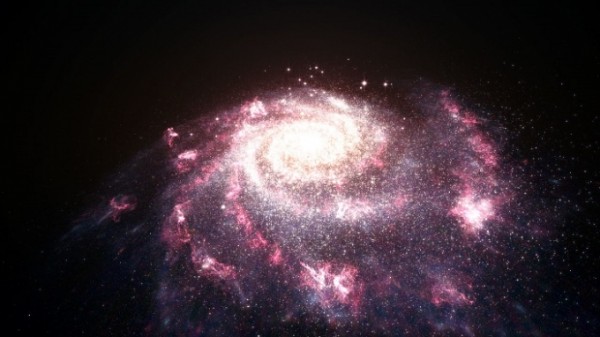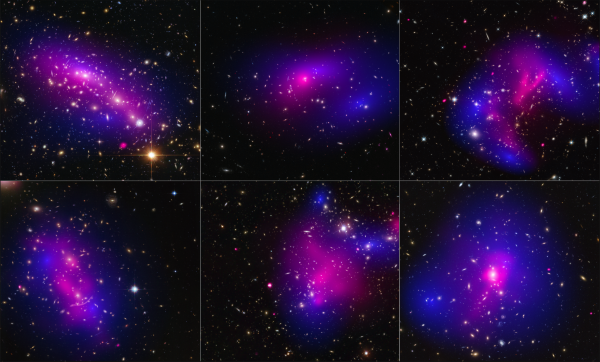Perhaps one of the latest buzzwords in the news is the strange, potentially deadly material known as dark matter.
It is thought to comprise roughly 85 percent of the total matter throughout the cosmos and makes up about 27 percent of the Universe as we know it.
Now, for what may be the first time, this elusive quantity may have been spotted interacting alongside other particles of dark matter, in a star cluster approximately 1.4 billion light-years away from home.
Previous analysis done of colliding galaxy clusters have indicated that dark matter hardly interacts with anything at all. It is largely known by the gravity which it exerts, and the radiation that shines off of it.
The latest discovery, published this week in Monthly Notices of the Royal Astronomical Society, may suggest that exotic physics are at play – reaching well beyond the explanations offered by current theories.
The more widely accepted theories suggest that visible matter found in galaxies – a slim minority of the universe – exists within heaps of dark matter. If this dark matter did not contain the gravity necessary for their stability, galaxies including our Milky Way would gradually rip themselves apart while spinning.
As significant as it may be, the real nature of dark matter remains as mysterious as ever. So far, gravity seems to be the only known force with which it interacts.
Although many by and large believe that dark matter’s interactions are associated with one specific particle, the currently accepted theory of physics known as the Standard Model has yet to assign one.
In their study, a team of astronomers led by Dr. Richard Massey of Durham University studied a simultaneous collision between four different galaxies within the cluster Abell 3827.
Despite the fact that dark matter cannot be seen by the human eye, this team was capable of determining its location with the help of a technique known as gravitational lensing. Although dark matter can neither absorb nor give off light, it does contain gravity.
Much like when you place an object in a glass of water, dark matter distorts the pathway of any light passing nearby, altering our view of anything that may be the other side of the dark matter cluster. The dark matter within Abell 3827 twisted the path of the light rays emanated by a galaxy in the distant background, the one that just happened to be aligned perfectly for the team’s research. The Large Hadron Collider, which recently discovered the Higgs boson, or God particle, will also be making great strides in the hunt for dark matter. This month, after some initial delay, it commenced its second run. Kept at the French-Swiss border, this machine is currently firing up to strike protons with energies stronger and faster than ever before.
Dark matter is also thought to have influenced the Earth’s orbit on particular cycles within galaxies, and influencing dark matter already within our planet, meaning it may be suspect behind a number of extinction events. While there is still much to be found out, scientists are also deeper in their understanding of dark matter than ever before, and there is a large-scale effort currently under way to map out all dark matter found throughout the sky. The latest map suggests that dark matter outnumbers visible matter with a five to one ratio. Researchers hope to complete their map by the year 2018.
The researchers discovered that one particular clump of dark matter seemed to actually lag behind the galaxy which it surrounds. Such a lag between the dark matter and its associated galaxy would be expected if the mysterious stuff was interacting with itself – utilizing a force besides mere gravity. Although visible matter often interacts with other particles in normal ways, it is the dark matter that causes materials to lag behind, forming gravitational halos that cause a 5,000 light-year lag.
“We used to think that dark matter just sits around, minding its own business, except for its gravitational pull,” said Massey in an interview with Discovery News. “But if dark matter were being slowed down during this collision, it could be the first evidence for rich physics in the dark sector — the hidden Universe all around us.”
When Dr. Massey and colleagues had previously studied the collisions between enormous conglomerations of galaxies, such as the Bullet Cluster, infamous in dark matter studies for being one of the hottest clusters in the universe, they noticed that despite these violent collisions, the dark matter hardly slowed down at all.
“The Bullet Cluster collision took place at incredibly high speed,” Dr. Massey said in an interview with BBC News.
“But in this individual galaxy, the collision could have been going on for a long period of time.
“You would expect a small tiny force to build up over time, giving you a bigger offset to detect whether the dark matter interacts – just slightly. That’s why we looked at them.”
This slight interaction observed among the dark matter will probably need the more exotic theories of physics to evolve beyond what is already explained by the Standard Model.
“You just need the special conditions to enable this to be seen,” explained Dr. Massey.
Research that was published by this same team back in March placed an upper limit over the interaction between dark matter and its surroundings. Their newer research will focus on the lower limit.
“We are finally homing in on dark matter from above and below – squeezing our knowledge from two directions,” said Richard Massey.
|
James Sullivan
James Sullivan is the assistant editor of Brain World Magazine and a contributor to Truth Is Cool and OMNI Reboot. He can usually be found on TVTropes or RationalWiki when not exploiting life and science stories for another blog article. |


